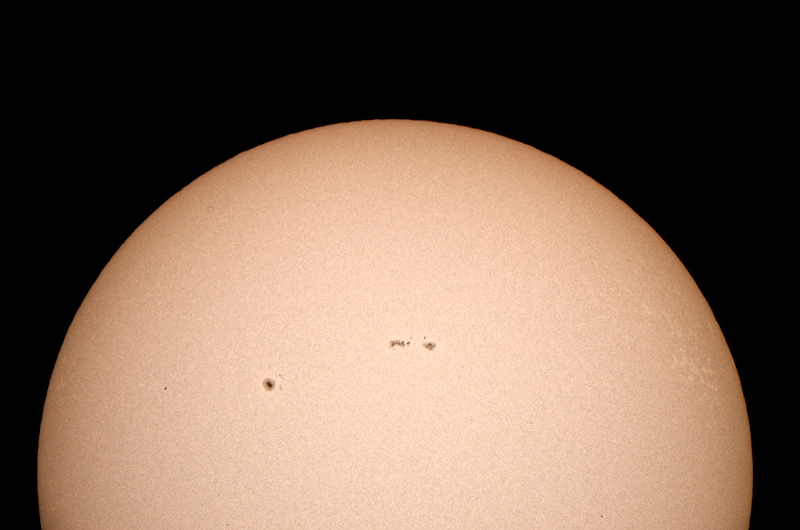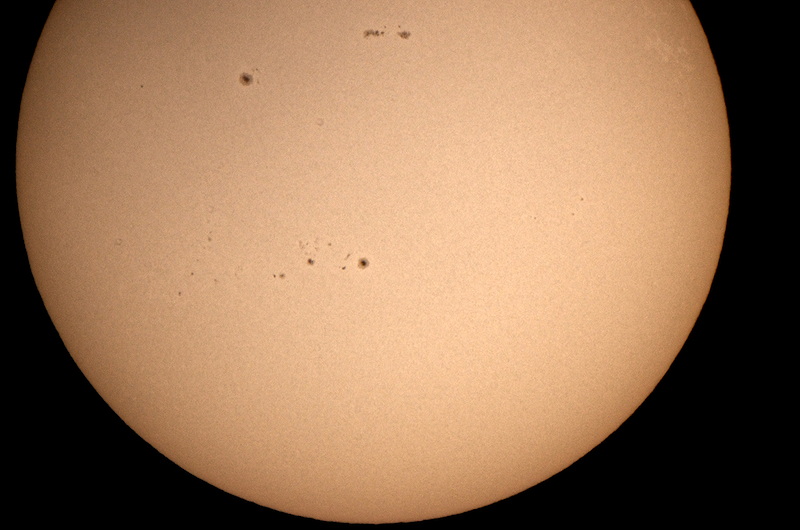
Transit of Venus Dry Run
Posted: 4 June 2012
As I did in preparation for the partial solar eclipse in May, I did a dry-run on Monday, 4 June 2012, in preparation for the Transit of Venus to occur on Tuesday, 5 June. I opened the observatory at 1400 MST, 106°F. There was a strong breeze blowing (gusts to 18mph), but the sky was clear.
At 1410 MST, I tried to observe Venus in the 8" by blocking the sun with the observatory dome, but I was unsuccessful.
The Meade 8" LX200-ACF had the Orion full-aperture solar filter. I also set up the Meade ETX-90RA with a Coronado White Light Solar Filter and the Coronado PST was mounted piggyback.
At 1504 MST, I begin doing test imaging of the sun with the D7000 DSLR at prime focus of the 8". The camera was mounted on the star diagonal. I wanted a little bit of magnification to best show Venus during the transit. I also tested the Vello Wireless ShutterBoss Timer Remote for doing timed sequence exposures every 1 minute. Unfortunately, the mirror lockup mode would not work with the automatically sequenced exposures. So, I will use the Nikon Wireless Remote ML-L3 to make exposures every 1 minute from First Contact through Second Contact. I'll just have to watch the clock. I also tested various exposure settings. During post-processing I decided that I would use 1/800sec, ISO 800, for the transit.
Occasionally, I would check the view in the ETX-90RA and PST. As with the 8", the ETX at 48X showed several nice sunspots. The PST (32X) showed two nice prominences and several good filaments across the solar disk.
I decided to switch the PST from being piggybacked on the ETX to a photographic tripod. That way, any guests who come to view the transit can use either telescope. The 8" LX200-ACF will be dedicated to imaging.
At 1800 MST, with the sun almost into a tree, I took this image, 1/800sec, ISO:

I then removed the camera and inserted the 26mm (77X) eyepiece. I came to realize that I had been doing my test imaging on the southern portion of the sun instead of the northern portion where the transit will occur! The image above shows what the camera was seeing and is inverted. Of course, I knew that would be the case, but when I first set up for solar imaging today, I studied a printout I had made of the sun's disk showing today's sunspots and compared that to the view in the camera's viewfinder. I must have misidentified the sunspots and totally ignored the image rotation. Maybe it was the heat affecting the brain!!! Anyway, that's why I did a dry run and it proved its worth.
This is a correct view (but inverted, as seen by the camera) showing the northern portion of the sun, 1/800sec, ISO 800:

At 1825 MST, the sun was in the tree, so I began closing up.
Closed the observatory at 1833 MST, 88°F. I kept using the ETX-90RA until sunset.
The forecast for tomorrow, transit day, is for strong winds.
Comments are welcome; use the Comments section below, or you can Email Me. Thanks.
Go to the previous report.
Return to the Cassiopeia Observatory Welcome Page.